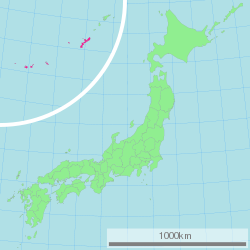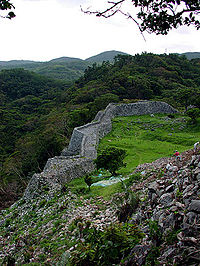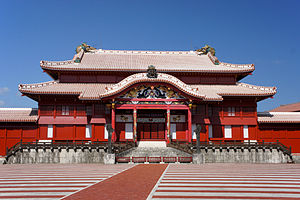- History of the Ryukyu Islands
-
This article is about the history of the Ryukyu Islands southwest of the main islands of Japan.
Okinawa Prefecture Japanese transcription(s) – Japanese 沖縄県 – Rōmaji Okinawa-ken Okinawan transcription(s) – Okinawan ウチナー県 – Rōmaji Uchinaa-ken 
Symbol of History of the Ryukyu IslandsCountry Japan Region Kyūshū Island Okinawa Capital Naha Government – Governor Hirokazu Nakaima Area – Total 2,271.30 km2 (877 sq mi) Area rank 44th Population (December 1, 2008) – Total 1,379,338 – Rank 32nd – Density 606/km2 (1,569.5/sq mi) ISO 3166 code JP-47 Districts 5 Municipalities 41 Flower Deigo (Erythrina variegata) Tree Pinus luchuensis (ryūkyūmatsu) Bird Okinawa woodpecker (Sapheopipo noguchii) Fish Banana Fish (Caesio diagramma,"Takasago", "Gurukun") Website www.pref.okinawa.jp/
english/Contents
Etymology
The name Ryukyū originates from Chinese writings, while "Okinawa" was coined in Okinawa.[1][2] The earliest references to "Ryukyū" write the name as 琉虬 (Mandarin Pinyin: Líuqíu; Jyutping: Lau4kau4) in the Chinese history Book of Sui in 607. It is a descriptive name, meaning "glazed horn-dragon".
The origin of the term "Okinawa" remains unclear, though there was a divine woman named Okinawa in the book Omoro Soshi, a compilation of ancient poems and songs from Okinawa. This suggests the presence of a divine place named Okinawa. The Chinese monk Jianzhen, who traveled to Japan to promote Buddhism, wrote of the Okinawa as 阿児奈波 (pinyin: A'érnàibō; Cantonese Jyutping: Aa2ngai4noi6bo1 ; Japanese: Akainaha). The current Chinese characters (kanji) for Okinawa – 沖縄 – were first written in 1719 by Arai Hakuseki, a Japanese scholar, in the book Record of Southern Islands.
Early history
Prehistoric Period
The ancestry of the modern-day Ryukyuan people is disputed. One theory claims that the earliest inhabitants of these islands crossed a prehistoric land bridge from modern-day China, with later additions of Austronesians, Micronesians, and Japanese merging with the population.[3]
The time when human beings first appeared in Okinawa remains unknown. The earliest human bones were those of Yamashita Cave Man, about 32,000 years ago, followed by Pinza-Abu Cave Man, Miyakojima, about 26,000 years ago and Minatogawa man, about 18,000 years ago. Of them, perfect bodies were excavated of the Minatogawa man. They probably came through China and were once considered to be the direct ancestors of those living in Okinawa. No stone tools were discovered with them. For the following 12,000 years, no trace of archaeological sites was discovered after the Minatogawa man site.[citation needed][4]
Okinawa Midden Culture
Okinawa midden culture or shell heap culture is divided into the early shell heap period corresponding to the Jomon age of Japan and the latter shell heap period corresponding to the Yayoi period of Japan. However, the use of Jomon and Yayoi of Japan is questionable in Okinawa. In the former, it was a hunter-gatherer society, with wave-like opening Jomon pottery. In the latter part of Jomon period, archaeological sites moved near the seashore, suggesting the engagement of people in fishery. In Okinawa, rice was not cultivated in the Yayoi culture, and cultivation started in the latter period of shell-heap age. Shell rings for arms made of shells obtained in the Sakishima Islands, namely Miyakojima and Yaeyama islands, were imported by Japan. In these islands, the presence of shell axes, 2500 years ago, suggests the influence of a southeastern-Pacific culture.[citation needed][5][6]
Mythology, the Shunten Dynasty and the Eiso Dynasty
The first history book of Okinawa is Chuzanseikan (Mirrors of Chuzan), which was compiled by Sho Shoken (向象賢) (1617–1675), also known as Haneji Choshu (羽地朝秀). This and in other books, Minamoto no Tametomo (源 為朝?, 1139–1170), tell the story about a Japanese samurai who fought in the Hogen Rebellion of 1156 and fled first to Izu Island and then to Okinawa. He settled down with the sister of an anji and sired Shunten, the first king of Okinawa. Most historians, however, discount this story as a revisionist history that is intended to legitimize Japanese domination over Okinawa. The Shunten's dynasty ended in the third generation when his grandson, Gihon, abdicated, went into exile, and was succeeded by Eiso, who began a new royal lineage. The Eiso (Ryukyu) Dynasty continued for five generations.[citation needed][7][8]
Gusuku Period
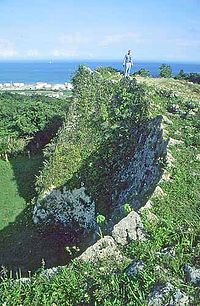 Wall of Gusuku
Wall of Gusuku
Gusuku is the term used for the distinctive Okinawan form of castles or fortresses. Many gusukus and related cultural remains in the Ryukyu Islands have been listed by UNESCO as World Heritage Sites under the title Gusuku Sites and Related Properties of the Kingdom of Ryukyu. After the midden culture, agriculture started about the 12th century, with the center moving from the seashore to higher places. This period is called the gusuku period. There are three perspectives regarding the nature of gusukus: 1) a holy place, 2) dwellings encircled by stones, 3) a castle of a leader of people. In this period, porcelain trade between Okinawa and other countries became busy, and Okinawa became an important relay point in eastern-Asian trade. Ryukyuan kings, such as Shunten and Eiso, were considered to be important governors. In 1291, there was an intended invasion of Mongol, but the Eiso Dynasty defended its land. Hiragana was imported from Japan by Ganjin in 1265. Noro, female shaman or priests (as in shintoism), appeared.
The nature of Okinawan people
Early Chinese visitors noted the hospitality of the islanders, as well as the sharp economic divisions between the small upper class and the impoverished masses. Along with the arrival of European explorers in the nineteenth century, the Ryukyuans also came into contact with the Dutch, the Portuguese, the English and others, who always noted the hospitality of the natives.[citation needed]
The dominant economy has historically been based on the farming of sugar cane, and later on, the sweet potato. In 1605, Noguni Soukan brought seedlings of the sweet potato to Chatan, and Gima Shinjo(1557–1644) successfully spread the sweet potato.[clarification needed] It was later planted in Satsuma where it became known nationally as "the Satsuma potato."[9][10] Other farmed items include guava, banana, papaya, and tobacco.[citation needed]
In the fifteenth and sixteenth centuries, the Ryukyuans traded from Java to Japan, as well as with China and Korea. This led to an increased level of prosperity for the kingdom.[citation needed]
Three-Kingdom period
The Three-Kingdom period, also known as the Sanzan period (三山時代 Sanzan-jidai), lasted from 1322 until 1429. There was a gradual consolidation of power. This culminated in the unification of the Ryūkyū Kingdom.[citation needed]Every country became a tributary to the Ming dynasty.
Shō Hashi (1372–1439) conquered the middle state and made his father Sho Shi Sho the king of the middle state in 1404, and conquered the northern state of Han An Chi in 1416, and conquered the southern state in 1429, thereby unifying Ryukyu.
Ryūkyū Kingdom
Main article: Ryūkyū KingdomRyūkyū Kingdom
琉球國← 
←
←
1429–1879  →
→
 →
→

Flag Royal Seal Capital Shuri Language(s) Ryukyuan (native languages), Japanese Religion native Ryukyuan religion, Buddhism, Confucianism, Shinto, Taoism Government Monarchy King (国王) - 1429–1439 Shō Hashi - 1477–1526 Shō Shin - 1587–1620 Shō Nei - 1848–1879 Shō Tai Sessei (摂政) - 1666–1673 Shō Shōken Kokushi (国司) - 1751–1752 Sai On Legislature Shuri Ō-fu (首里王府), Sanshikan (三司官) History - Unification 1429 - Satsuma invasion April 5, 1609 - Prefecture reform 1871 - Annexed by Japan March 11, 1879 Area 2,271 km2 (877 sq mi) ¹ Ming and Qing dynasties. In 1429, King Shō Hashi completed the unification of the three kingdoms and founded one Ryūkyū Kingdom with its capital at Shuri Castle.[citation needed]
 King Shō Shin
King Shō Shin
Shō Shin (尚真)(1465–1526; r. 1477–1526) was the third king of the Second Sho Dynasty, whose reign has been described as the "Great Days of Chūzan", a period of great peace and relative prosperity. He was the son of Shō En, the founder of the dynasty, by Yosoidon, Shō En's second wife, often referred to as the queen mother. He succeeded his uncle, Shō Sen'i, who was forced to abdicate in his favor. Much of the foundational organization of the kingdom's administration and economy is traced back to developments which occurred during Shō Shin's reign. The reign of Shō Shin also saw the expansion of the kingdom's control over several of the outlying Ryukyu Islands, such as Miyakojima and Ishigaki Island.[citation needed]
Main article: Shō ShinMany Chinese moved to Ryukyu to serve the government or engage in business during this period. The Ming dynasty Chinese sent from Fujian 36 Chinese families at the request of the Ryukyuan King to manage oceanic dealings in the kingdom in 1392 during the Hongwu Emperor's reign. Many Ryukuan officials were descended from these Chinese immigrants, being born in China or having Chinese grandfathers.[11] They assisted in the Ryukyuans in advancing their techonology and diplomatic relations.[12][13][14]
Satsuma domination, 1609–1871
Near the end of the sixteenth century, Japanese feudal leader Toyotomi Hideyoshi ordered the Ryūkyū kingdom to support Hideyoshi’s invasions of Korea with men and arms. However, the kingdom was already a tribute state of China. The kingdom’s policy was to not participate in military efforts against China, and they certainly did not wish to risk losing their Chinese trade. The Japanese proceeded with their attack on the Korean peninsula without the aid of the Ryūkyū kingdom. During this same period a ferocious battle of succession arose in the Ryūkyū kingdom due to the death of Hideyoshi. The Shimazu clan of Satsuma, the nearest Japanese neighbors of the kingdom, were the victors.[citation needed]
The Shimazu clan not only wanted its share of the Ryūkyūan trade with mainland Japan and Southeast Asia, but also to gain favor with the regime in Edo (modern-day Tokyo). The kingdom had not paid respects to the new regime; therefore, permission was granted by the rulers in Edo to invade the kingdom.[citation needed]
The invasion of the Ryūkyūs by Satsuma took place in April 1609. Three thousand men and more than one hundred war junks sailed from Kagoshima at the southern tip of Kyūshū. The Ryūkyūans did not put up a fight, due to the order of the king, who told them “nuchidu takara” (Life itself is a treasure). Many priceless cultural treasures were looted and taken to Kagoshima.[citation needed]
The kingdom became a tribute state of both China and the Satsuma clan, with Satsuma exercising ultimate control. Because China would not make a formal trade agreement unless a country was a tribute state, the kingdom was a convenient loop-hole for Japanese trade with China. When Japan officially closed off trade with European nations except the Dutch, Nagasaki and Ryūkyū became the only Japanese trading ports offering connections with the outside world.[citation needed]
This period of effective outside control also featured the first-ever international matches of Go, as Ryūkyūan players came to Japan to test their skill. This occurred in 1634, 1682 and 1710.[15][16]
The Shimazu introduced the policy of banning sword ownership by commoners, already well established on the mainland. This led to the development of the indigenous martial art karate, which utilizes domestic items as weapons.[citation needed]
Perry's "black ships", official envoys from the United States, came in 1853.[17]
Mudan Incident of 1871 occurred, in which fifty-four Ryukyu people were killed in Taiwan. They wandered into the central part of Taiwan after their ship was wrecked.
Ryūkyū Province, 1872–1879
Main article: Ryūkyū ProvinceIn 1872, the Ryūkyū Kingdom was reconfigured as Ryūkyū Province.[18] The former kingdom was formally reorganized as Ryūkyū han.[19]
After the Taiwan Expedition of 1874, Japan's role as the protector of the Ryukyuan people was acknowledged; but the sovereignty of the Ryukyu islands remained indefinite. The fiction of independence was maintained for diplomatic reasons.[20]
Okinawa Prefecture, 1879–1945
In 1879, Ryūkyū Province and han was renamed Okinawa Prefecture by the Meiji government and the monarchy in Shuri was abolished. The deposed king Shō Tai (1843–1901) was forced to relocate to Tokyo. In compensation, he was made a marquis in the Meiji system of peerage.[21]
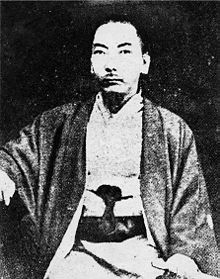 The last King Shō Tai
The last King Shō Tai
Hostility against mainland Japan increased in the Ryūkyūs immediately after its annexation to Japan. Japan introduced modern institutions, based on Western models, including public education using standard Japanese. This increased the number of Japanese language speakers on the islands, creating a link with the mainland. When Japan became the dominant power of the Far East, many Ryūkyūans were proud of being citizens of the Empire. However, there was always an undercurrent of dissatisfaction for being treated as a second class citizens. For example, during an earlier part of the Meiji era, Japan offered Miyako and Yaeyama islands to the Qing Dynasty in exchange for treaty concessions, though the negotiation eventually failed.[citation needed]
The mongoose was introduced from India in 1910 to control the poisonous habu snake.[citation needed]
Historical description
In 1878, the islands were listed as a "tributary" to Japan. The largest island was listed as "Tsju San", meaning "middle island." Others were listed as Sannan in the south and Sanbok in the North Nawa. The main port was listed as "Tsju San." It was open to foreign trade.[22]
Agricultural produce included tea, rice, sugar, tobacco, camphor, fruits, and silk. Manufactured products included cotton, paper, porcelain, and lacquered ware.[22]
The people were described as appearing to be a "connecting link" between the Chinese and Japanese.[22]
Okinawa and World War II
In the years leading up to World War II, the Japanese government sought to reinforce national solidarity in the interests of militarization. They did so by means of conscription, mobilization, and nationalistic propaganda. People of the Ryukyu Islands, having spent only a generation as full Japanese citizens, were interested in proving their value to the nation in spite of prejudice expressed by mainland Japanese people, the mainland Japanese politicians appointed to govern Okinawa, and the mainland Japanese generals commanding Okinawa military units.[23]
The Japanese government also promoted Japanese-language education in the school system to render the islanders Japanese citizens.[citation needed]
Princess Lilies
Main article: Himeyuri StudentsAfter the beginning of World War II, the Japanese military conscripted school girls (15 to 16 years old) to join a group known as the Princess Lilies (Hime-yuri) and to go to the battle front as nurses. There were seven girls' high schools in Okinawa at the time of World War II. The Princess Lilies were organized at two of them, and a total of 297 students and teachers eventually joined the group. Two hundred eleven died. Most of the girls were put into temporary clinics in caves to take care of injured soldiers. With a severe shortage of food, water and medicine, many of the girls died while trying to care for the wounded soldiers.[citation needed]
The Japanese military had told these girls that, if they were taken as prisoners, the enemy would rape and kill them; the military gave hand grenades to the girls to allow them to commit suicide rather than be taken as prisoners. One of the Princess Lilies explained: "We had a strict imperial education, so being taken prisoner was the same as being a traitor. We were taught to prefer suicide to becoming a captive."[24] Many students died saying "Tenno Heika Banzai", which means "Long live the Emperor."
The board of education, made up entirely of mainland Japanese, required the girls' participation. Teachers, who insisted that the students be evacuated to somewhere safe, were accused of being traitors.[citation needed]
Battle of Okinawa
Main article: Battle of OkinawaSee also: Rape during the occupation of JapanThe Battle of Okinawa was one of the last major battles of World War II, claiming the lives of an estimated 120,000 combatants. The Ryukyus were the only inhabited part of Japan to experience a land battle during World War II. In addition to the Japanese military personnel who died in the Battle for Okinawa, more than one third of the civilian population, 300,000 people, were killed, and many important documents, artifacts, and sites related to Ryukyuan history and culture were destroyed, including the royal Shuri Castle.[25] Americans had expected the Okinawan people to welcome them as liberators but the Japanese had used propaganda to make the Okinawans fearful of Americans. As a result, some Okinawans joined militias and fought along Japanese. This was a major cause of the civilian casualties, as Americans could not distinguish between combatants and civilian.[citation needed]
Due to fears concerning their fate during and after the invasion, the Okinawan people hid in caves and in family tombs. Several mass deaths occurred, such as in the "Cave of the Virgins", where many Okinawan school girls committed suicide by jumping off cliffs for fear of rape. Similarly, whole families committed suicide or were killed by near relatives in order to avoid suffering what they believed would be a worse fate at the hands of American forces; for instance, on Zamami Island at Zamami Village, almost everyone living on the island committed suicide two days after Americans landed.[26] Although the Americans had made plans to safeguard the Okinawans,[27] their fears were not entirely unfounded, as killing of civilians and destruction of civilian property did take place; for example, on Aguni Island, 90 residents were killed and 150 houses were destroyed.[28]
As the fighting intensified, Japanese soldiers hid in caves with civilians, further increasing civilian casualties. Additionally, Japanese soldiers shot Okinawans who attempted to surrender to Allied Forces. America utilized Nisei Okinawans in psychological warfare, broadcasting in Okinawan, leading to the Japanese belief that Okinawans that did not speak Japanese were spies or disloyal to Japan, or both. These people were often killed as a result. As food became scarce, some civilians were killed over small amounts of food. "At midnight, soldiers would wake up Okinawans and take them to the beach. Then they chose Okinawans at random and threw hand grenades at them."[24]
Massive casualties in the Yaeyama Islands caused the Japanese military to force people to evacuate from their towns to the mountains, even though malaria was prevalent there. Fifty-four percent of the island's population died due to starvation and disease. Later, islanders unsuccessfully sued the Japanese government. Many military historians believe that Okinawa led directly to American use of the atomic bomb on Hiroshima and Nagasaki. A prominent holder of this view is Victor Davis Hanson, who states it explicitly in his book Ripples of Battle.[29] The theory goes: "because the Japanese on Okinawa, including native Okinawans, were so fierce in their defense (even when cut off, and without supplies), and because casualties were so appalling, many American strategists looked for an alternative means to subdue mainland Japan, other than a direct invasion."
Even today, unexploded ordnance can from time to time be a danger, especially in sparsely-populated areas where it may have lain undisturbed or been buried.[30]
Post-war occupation
Main article: Occupation of JapanAfter the war, the islands were occupied by the United States and run by a U.S. military government even after the end of the occupation of Japan as a whole in 1952. The United States dollar was the official currency used, and cars drove on the right, American-style, as opposed to on the left as in Japan. The islands switched to driving on the left in 1978, six years after they were returned to Japanese control.[citation needed]
The U.S. used their time as occupiers to build large army, air force, navy, and marine bases on Okinawa.
On November 21, 1969 U.S. President Richard Nixon and Japanese Prime Minister Eisaku Sato signed the Okinawa Reversion Agreement in Washington, D.C. on June 17, 1971.[31] The U.S. reverted the islands to Japan on May 15, 1972, setting back a Ryūkyū independence movement that had emerged. Under terms of the agreement, the U.S. retained its rights to bases on the island as part of the 1952 Treaty to protect Japan, but those bases were to be nuclear-free. The United States military still controls about 19% of the island, making the 30,000 American servicemen a dominant feature in island life. While the Americans provide jobs to the locals on base, and in tourist venues, and pay rent on the land, widespread personal relationships between U.S. servicemen and Okinawan women remain controversial in Okinawan society. Okinawa remains Japan's poorest prefecture.[citation needed]
Some Okinawans refuse to raise the Japanese flag at official events. Because of its perceived connection to Japanese Imperialism, many on the left of political affiliation will refuse to raise the flag, though some undoubtedly have additional nationalistic motives.[citation needed]
Tension with the U.S.
The American military has had a troubled history with Okinawa ever since the battle of Okinawa. During the occupation, American military personnel were exempt from domestic jurisdiction. Some American soldiers committed crimes or drove recklessly, occasionally killing locals when they did, but were not punished in civilian courts.[clarification needed] Okinawans clearly resented being occupied after the war.[clarification needed]
The Treaty of San Francisco which went into effect in 1952, officially ended wartime hostilities.
A sentiment in Okinawa was already moving toward reverting to Japan and the movement to restore Okinawa to Japan's control rose in the 1960s, inspired in part by the crash of a United States Air Force fighter jet into an elementary school that killed 11 students and six residents of the nearby neighborhood on June 30, 1959.[32][33]
In 1960, a U.S.–Japan Status of Forces Agreement became affective between the two countries, governing the rights and status of the American Armed Forces in Japan.
On December 20, 1970, a car accident involving members of the U.S. military and a local man in Koza (Okinawa City) led to an unprecedented riot, known as the Koza riot.
Okinawans started to demonstrate in mass to demand reunification with Japan and the growing antibase movement spurred Japan and the U.S. to negotiate on the issue.[33]
Later, evidence emerged that the US may have stored and used Agent Orange at its bases and training areas on the island.[34] In at least one location where Agent Orange was reportedly used, there have been unexplained incidences of leukemia among locals, one of the listed effects of Agent Orange exposure. The United States denies that Agent Orange was used, stored, or disposed of on the island. Drums that were unearthed in 2002 in one of the reported disposal locations were seized by the Okinawa Defense Bureau, an agency of Japan's Ministry of Defense, which has not issued a report on what the drums contained.[35] The United States denies that Agent Orange was ever present on Okinawa.[36]
Some Okinawan people hoped to remove American military from Okinawa. However, after Okinawa was reunited in 1972, Japan immediately signed a treaty with the U.S. so that the American military could stay in Okinawa.[citation needed]
The legal agreement remained the same. Whenever American military personnel was accused of a crime against an Okinawan, his superiors claimed jurisdiction to try him as part of SOFA (Status of Forces Agreement) status, automatically putting the accused beyond the reach of Japanese law enforcement.[citation needed]
In 1995, two Marines and a sailor kidnapped and raped a 12-year-old girl and left her for dead, and under the SOFA with the U.S., local police and prosecutors were unable to get access to the troops until they were able to prepare an indictment. What surprised many in this instance was not just the nature of crime but also that, in this instance, the suspects were handed over to Japanese police.[citation needed]
Other complaints are that the military bases disrupt the lives of the Okinawan people; the American military occupy more than a fifth of the main island. The biggest and most active air force base in east Asia, Kadena Air Base, is based on the island; the islanders complain the base produces large amounts of noise and is dangerous in other ways. In 1959 a jet fighter crashed into a school on the island, killing 17 children and injuring 121. On August 13, 2004, a U.S. military helicopter crashed into Okinawa International University, injuring the three crew members on board. The U.S. military arrived on scene first then physically barred local police from participating in the investigation of the crash. The US did not allow local authorities to examine the scene until six days after the crash.[37][38][39][40][41]
While the bases do provide revenue it is claimed that they are holding the island's development back.[citation needed] Base-related revenue makes up 5% of the total economy. If the U.S. vacated the land, it is claimed[who?] that the island would be able to generate more money from tourism by the increased land available for development.[citation needed] In the 1990s, a Special Actions Committee was set up to prepare measures to ease tensions, most notably the return of approximately 50 km² to the Japanese state.[citation needed]
On February, 2008, a U.S. Marine was arrested for allegedly raping a 14-year-old Japanese girl in Okinawa,[42] and a member of the U.S. Army was suspected on raping a Filipino woman in Okinawa.[43] U.S. Ambassador Thomas Schieffer flew to Okinawa and met with Okinawa governor Hirokazu Nakaima to express U.S. concern over the case and offer cooperation in the investigation.[44] U.S. Forces Japan designated February 22 as a Day of Reflection for all U.S. military facilities in Japan, setting up a Sexual Assault Prevention and Response Task Force in an effort to prevent similar incidents.[45]
Notables
- Uechi Kanbun was the founder of Uechi-ryū, one of the primary karate styles of Okinawa
- Mitsuru Ushijima was the Japanese general at the Battle of Okinawa, during the final stages of World War II.
- Isamu Chō was an officer in the Imperial Japanese Army known for his support of ultranationalist politics and involvement in a number of attempted military and right-wing coup d'etats in pre-World War II Japan.
- Ota Minoru was an admiral in the Imperial Japanese Navy during World War II, and the final commander of the Japanese naval forces defending the Oroku Peninsula during the Battle of Okinawa.
- Sato Eisaku was a Japanese politician and the 61st, 62nd and 63rd Prime Minister of Japan. During his premier days, Okinawa was returned to Japan.
- Yabu Kentsu) was a prominent teacher of Shōrin-ryū karate in Okinawa from the 1910s until the 1930s, and was among the first people to demonstrate karate in Hawaii.
- Takuji Iwasaki was a Japanese meteorologist, biologist, ethnologist historian.
- Ernest Taylor Pyle was an American journalist who wrote as a roving correspondent for the Scripps Howard newspaper chain from 1935 until his death in combat during World War II. He died in IeJima, Okinawa.
- Lieutenant-General Simon Bolivar Buckner, Jr. was killed during the closing days of the Battle of Okinawa by enemy artillery fire, making him the highest-ranking US military officer to have been killed by enemy fire during World War II.
See also
- History of Amami Islands
- History of Sakishima Islands
- Ethnic issues in Japan
- Okinawa prefecture
- Ryukyuan people
- Ryūkyū Kingdom
- Okinawan Samurai
- Gusuku
- Mudan Incident of 1871
- Iha Fuyū
- Shuri castle
- Bernard Jean Bettelheim
Notes
- ^ Minamijima Fudoki Chimei-gaisetsu Okinawa, Higashionna Kanjun, p.16 in Japanese
- ^ The transition of Okinawa and Ryukyu Ryukyu-Shimpo-Sha, 2007, in Japanese
- ^ An Austronesian Presence in Southern Japan: Early Occupation in the Yaeyama Islands, Glenn R. Summerhayes and Atholl Anderson, Department of Anthropology, Otago University, retrieved November 22, 2009
- ^ Arashiro Toshiaki ’’High School History of Ryukyu, Okinawa Toyo Kikaku, 2001, p10-11. ISBN 4-938984-17-2 in which 3 more sites in Okinawa were written. Coral islands favor the preservation of olden human bones.
- ^ Arashiro Toshiaki High School History of Ryukyu, Okinawa, Toyo Kikaku, 2001, p12,ISBN 4-938984-17-2 p20
- ^ Ito, Masami, "Between a rock and a hard place", Japan Times, May 12, 2009, p. 3.
- ^ '’Mazakaina Yasuoki Zenshu Mazakaina Yasuoki Vol. 1 p 19. The original Japanese says that there was no question that people of Okinawa came from Japan. The Okinawans know the names for heaven, mountain, river, bird, tree, and vegetable but that the remoteness of time separated the languages.
- ^ Hiroto Takamiya of Sapporo University states that recent gene studies revealed that Okinawan people and Japan proper (north of Kyushu) people shared the same ancestors. Asahi Shimbun, Apr 16, 2010
- ^ Satuma Imo
- ^ Arashiro Toshiaki High School History of Ryukyu and Okinawa, Toyo Kikaku, 2001, p116
- ^ Shih-shan Henry Tsai (1996). The eunuchs in the Ming dynasty (illustrated ed.). SUNY Press. p. 145. ISBN 0791426874. http://books.google.com/books?id=Ka6jNJcX_ygC&pg=PA145&dq=ryukyu+asked+for+thirty+six+families+fujian&hl=en&ei=Z3NLTaSYG9L1gAeXkZEd&sa=X&oi=book_result&ct=result&resnum=1&ved=0CDIQ6AEwAA#v=onepage&q=ryukyu%20asked%20for%20thirty%20six%20families%20fujian&f=false. Retrieved 2011-02-04.
- ^ Angela Schottenhammer (2007). Angela Schottenhammer. ed. The East Asian maritime world 1400–1800: its fabrics of power and dynamics of exchanges. Volume 4 of East Asian economic and socio-cultural studies: East Asian maritime history. Otto Harrassowitz Verlag. p. xiii. ISBN 3447054743. http://books.google.com/books?id=Ga-5mPOr2-wC&pg=PR13&dq=ryukyu+asked+for+thirty+six+families+fujian&hl=en&ei=Z3NLTaSYG9L1gAeXkZEd&sa=X&oi=book_result&ct=result&resnum=5&ved=0CEgQ6AEwBA#v=onepage&q&f=false. Retrieved 2011-02-04.
- ^ Gang Deng (1999). Maritime sector, institutions, and sea power of premodern China. Volume 212 of Contributions in economics and economic history. Greenwood Publishing Group. p. 125. ISBN 0313307121. http://books.google.com/books?id=ddcV_cGegX4C&pg=PA125&dq=ryukyu+asked+for+thirty+six+families+fujian&hl=en&ei=Z3NLTaSYG9L1gAeXkZEd&sa=X&oi=book_result&ct=result&resnum=3&ved=0CDwQ6AEwAg#v=onepage&q&f=false. Retrieved 2011-02-04.
- ^ Katrien Hendrickx (2007). The Origins of Banana-fibre Cloth in the Ryukyus, Japan. Leuven University Press. p. 39. ISBN 9058676145. http://books.google.com/books?id=ULyu8dNqS1sC&pg=PA39&dq=ryukyu+asked+for+thirty+six+families+fujian&hl=en&ei=Z3NLTaSYG9L1gAeXkZEd&sa=X&oi=book_result&ct=result&resnum=2&ved=0CDcQ6AEwAQ#v=onepage&q&f=false. Retrieved 2011-01-11.
- ^ Sensei's Library: Ryukyuan players
- ^ MindZine – Go – Feature: Go in old Okinawa
- ^ [1]
- ^ Matsuo, Kanenori Sakon. (2005). The Secret Royal Martial Arts of Ryukyu, p. 40. at Google Books
- ^ Lin, Man-houng. "The Ryukyus and Taiwan in the East Asian Seas: A Longue Durée Perspective," Asia-Pacific Journal: Japan Focus. October 27, 2006, translated and abridged from Academia Sinica Weekly, No. 1084. August 24, 2006.
- ^ Goodenough, Ward H. Book Review: "George H. Kerr. Okinawa: the History of an Island People ...," The Annals of the American Academy of Political and Social Science, May 1959, Vol. 323, No. 1, p. 165.
- ^ Papinot, Jacques. (2003). Nobiliare du Japon – Sho, p. 56 (PDF@60); see also Papinot, Jacques Edmond Joseph. (1906). Dictionnaire d’histoire et de géographie du Japon.
- ^ a b c (Ross/Globe Vol. IV: Loo-Choo, 1878)
- ^ Kerr pgs 459–464
- ^ a b (Moriguchi, 1992)
- ^ The Age of Shuri Castle
- ^ Geruma lsland
- ^ Appleman, Roy E. (2000) [1948]. "Chapter I: Operation Iceberg". Okinawa:The Last Battle. The United States Army in World War II, The War in the Pacific. Washington, D.C.: United States Army Center of Military History. CMH Pub 5-11. http://www.history.army.mil/books/wwii/okinawa/chapter1.htm.
- ^ Aguni lsland
- ^ Hanson, Victor Davis, (October 12, 2004). "Ripples of Battle: How Wars of the Past Still Determine How We Fight, How We Live, and How We Think", Anchor, October 12, 2004, ISBN 0385721943 ISBN 978-0385721943
- ^ MACHINAMI : Ie Island
- ^ Okinawa Reversion Agreement – 1971
- ^ Teruo Hiyane: Okinawa shares much in common with Asia Asahi shinbun, December 12, 2007
- ^ a b Handover of Okinawa to Japan was prickly issue The Japan Times, May 14, 2002
- ^ Mitchell, Jon, "Evidence for Agent Orange on Okinawa", Japan Times, April 12, 2011, p. 12.
- ^ Mitchell, Jon, "Agent Orange buried on Okinawa, vet says", Japan Times, August 13, 2011, p. 1.
- ^ Mitchell, Jon, "Okinawa vet blames cancer on defoliant", Japan Times, August 24, 2011, p. 3.
- ^ No Fly Zone English Home
- ^ ZNet |Japan | Anger Explodes as a U.S. Army Helicopter Crash at Okinawa International University
- ^ Carol, Joe, "Futenma divides Okinawa's expats" Japan Times, June 8, 2010.
- ^ Kyodo News, "Bad memories of U.S. bases linger", Japan Times, April 29, 2010.
- ^ Takahara, Kanako, "Missing pin caused copter crash: report", Japan Times, October 6, 2004.
- ^ Anger spreads through Okinawa, The Japan TImes, Feb. 14, 2008
- ^ Japan probes new allegations of rape linked to U.S. military, CNN.com asia, February 20, 2008
- ^ U.S. envoy visits Okinawa, CNN.com asia, February 13, 2008
- ^ U.S. imposes curfew on Okinawa forces, The Japan Times, February 21, 2008
References
- Appleman, Roy E. et al. (1947), Okinawa: The Last Battle (LOC 49-45742)
- Feifer, George (1992), Tennozan (ISBN 0-395-70066-3)
- Kerr, George H. (1958). Okinawa: the History of an Island People. Rutland, Vermont: Charles Tuttle Co. OCLC 722356
- ___________. (1953). Ryukyu Kingdom and Province before 1945. Washington, D.C.: National Academy of Sciences, National Research Council. OCLC 5455582
- Matsuda, Mitsugu (2001), The Government of the Kingdom of Ryukyu, 1609–1872 (ISBN 4-946539-16-6)
- Rabson, Steve (1996), Assimilation Policy in Okinawa: Promotion, Resistance, and "Reconstruction", Japan Policy Research Institute.
- Ross, J.M. (editor) (1878). "Globe Encyclopaedia of Universal Information", Vol. IV, Edinburgh-Scotland, Thomas C. Jack, Grange Publishing Works, retrieved from Google Books 2009-03-18;
- Toshiaki, Arashiro. (2001). High School History of Ryukyu and Okinawa, Toyokikaku, in Japanese. (ISBN 4-938984-17-2)
- Okinawa Encyclopedia (3 volumes in Japanese) ,Okinawa Times, 1983.
External links
- A collection of essays miscellaneous historical topics
- (Japanese)沖縄の歴史情報(ORJ) Many Ryukyu historical texts.
- Many documents, including original and singular translations, concerning post-WWII Okinawa
- Wonder Okinawa, a comprehensive site run by the Okinawa Prefectural Government
- Information concerning UNESCO World Heritage Sites in the Ryukyu Islands
- Early Ryukyuan History as described by the Chinese
- Ryukyuan coins information and pictures concerning minting and circulation
- Brief History of the Uchinanchu (Okinawans)
Categories:- Former monarchies of Asia
- Former countries in Asia
- States and territories established in 1429
- States and territories disestablished in 1879
- Ryukyu Islands
- History of Japan
- History of China
Wikimedia Foundation. 2010.

